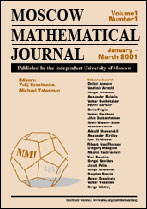|
This article is cited in 3 scientific papers (total in 3 papers)
Sturm's theorem on the zeros of sums of eigenfunctions: Gelfand's strategy implemented
Pierre Bérarda, Bernard Helfferb
a Université Grenoble Alpes and CNRS, Institut Fourier, CS 40700, 38058 Grenoble Cedex 9, France
b Laboratoire Jean Leray, Université de Nantes and CNRS, F44322 Nantes Cedex, France, and LMO, Université Paris-Sud
Abstract:
In the second section “Courant–Gelfand theorem” of his last published paper (Topological properties of eigenoscillations in mathematical physics, Proc. Steklov Institute Math. 273 (2011), 25–34), Arnold recounts Gelfand's strategy to prove that the zeros of any linear combination of the $n$ first eigenfunctions of the Sturm–Liouville problem
$$- y''(x) + q(x) y(x) = \lambda y(x) \text{ in } ]0,1[,\text{ with }y(0)=y(1)=0,$$
divide the interval into at most $n$ connected components, and concludes that “the lack of a published formal text with a rigorous proof …is still distressing.”
Inspired by Quantum mechanics, Gelfand's strategy consists in replacing the analysis of linear combinations of the $n$ first eigenfunctions by that of their Slater determinant, which is the first eigenfunction of the associated $n$-particle operator acting on Fermions.
In the present paper, we implement Gelfand's strategy, and give a complete proof of the above assertion. As a matter of fact, refining Gelfand's strategy, we prove a stronger property taking the multiplicity of zeros into account, a result which actually goes back to Sturm (1836). We also compare Gelfand's strategy to Kellogg's approach, and the theory of oscillation matrices and kernels.
Citation:
Pierre Bérard, Bernard Helffer, “Sturm's theorem on the zeros of sums of eigenfunctions: Gelfand's strategy implemented”, Mosc. Math. J., 20:1 (2020), 1–25
Linking options:
https://www.mathnet.ru/eng/mmj755 https://www.mathnet.ru/eng/mmj/v20/i1/p1
|

|




 Contact us:
Contact us: Terms of Use
Terms of Use
 Registration to the website
Registration to the website Logotypes
Logotypes







 Citation in format
Citation in format 
